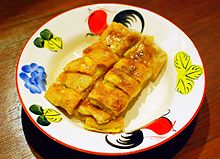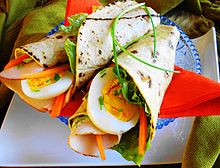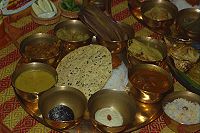- Roti
-
For the Indonesian island, see Rote Island. For the cooking method, see Rotisserie.For other uses, see Roti (disambiguation).
Roti 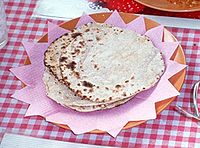
Indian flat roti, also known as chapatiOrigin Place of origin Indian subcontinent[1] Region or state South Asia Dish details Main ingredient(s) Atta flour Variations Chapati, Makki di roti, Tandoori roti, Roti canai Roti is generally a South Asian bread made from stoneground wholemeal flour, traditionally known as atta flour, that originated and is consumed in India, Pakistan, Bangladesh, Nepal and Sri Lanka. It is also consumed in parts of the Southern Caribbean, particularly in Guyana, Suriname, Trinidad and Tobago. Its defining characteristic is that it is unleavened. The Indian bread naan, in contrast, is a yeast-leavened bread.
Roti and its thinner variant, known as chapati, are an integral part of Indian / Pakistani cuisine.[2] It is particularly popular in India and Pakistan.[3]
Contents
Etymology
The word roti is derived from the Sanskrit word रोटिका (roṭikā), meaning "bread."[4] Names in other languages are Hindi: रोटी; Nepali: रोटी; Bengali: রুটি; Marathi: पोळी;Oriya: ରୁଟି; Kannada: ರೊಟ್ಟಿ; Telugu: రొట్టి; Urdu: روٹی; Dhivehi: ރޮށި; Punjabi: ਰੋਟੀ,ਫੂਲਕਾ; Tamil: ரொட்டி;Thai: โรตี. It is also known as rotli in Gujarati, maani in Sindhi and phulka in Punjabi and Saraiki.
India,Pakistan, Nepal, and Bangladesh
There are many different variations of flat breads found in many cultures across the globe, from Indian subcontinent to the Americas. The traditional flat bread originating from the Indian subcontinent is commonly known as roti, Nepali: रोटी; pronounced "rho tee". It is normally eaten with curries or cooked vegetables; it can be called a carrier for curries or cooked vegetables. It is made most often from wheat flour, cooked on a flat or slightly concave iron griddle called a tawa. It is similar to the tortilla in appearance. Like breads around the world, roti is a staple accompaniment to other foods, and may be spread with ghee (clarified butter).
-
Plain roti paratha
-
Indian thali with chapati
-
A chef preparing rumali roti in India
Sri Lanka
In Sri Lanka probably the most popular type of roti is pol roti (coconut roti), made of wheat flour, kurakkan flour or a mixture of both and scraped coconut. Sometimes chopped green chillies and onion are added to the mixture before cooking. These are usually thicker and harder than other roti types. They are usually eaten with curries, or some types of sambol or lunu miris and considered a main meal rather than a supplement.
Indonesia, Malaysia and Thailand
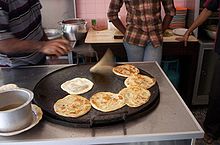 Roti canai being prepared at an Indian food outlet.
Roti canai being prepared at an Indian food outlet.
In Indonesia, Malaysia, and Somalia, the term encompasses all forms of bread including western-style bread as well as the traditional Punjabi breads.
In Thailand, "โรดี" refers to the maida paratha—known in Indonesia as roti maryam, roti cane or roti konde, Malaysia as roti canai and in Singapore as roti prata—which is sometimes drizzled with condensed milk, rolled up, and eaten as a hot snack, or fried with egg as a larger dish.
West Indies
In the Caribbean the word roti refers not only to the pastry but to the complete pastry with some sort of savory filling. In Asia 'roti' means what Caribbean people would call 'roti skins.' Roti also features prominently in the diet of many Caribbean countries, especially Trinidad and Tobago, Guyana and Suriname. West Indian roti are primarily made from wheat flour, baking powder, salt, and water and cooked on a tava. Certain rotis are also made with butter. There are several types of roti made in the West Indies.
Trinidad and Leeward Islands Food Description Sada roti This is a plain roti, made of white flour. Because it is the simplest roti to make, it is the most commonly consumed roti in Trinidad. It is a popular breakfast option in Trinidad, in combination with tomato choka, baigan choka (eggplant), and other vegetable dishes. Paratha roti A roti made with butter, usually ghee (Clarified Butter) but any butter can be used with it, the roti is put onto the tawa and butter is spread out onto it, partha eventually turns brown, and has more taste than the plain traditional roti, paratha is traditionally eaten with fried eggs and/or a cup of tea. A tawa is (a round, flat metal griddle used in Indian cooking). Ghee is rubbed on both sides, then it is cooked on the tawa. This gives the roti a crisp outside. When it almost finished cooking, the cook begins to beat the roti while it is on the tawa, causing it to crumble. It is also called 'Buss-Up-Shut' in Trinidad. Dosti roti A roti where two layers are rolled out together and cooked on the tava. It is also rubbed with oil while cooking. It is called dosti roti because the word dosti means friendship in Hindi. This type of roti is eaten in Guyana with a special halva when a child is born. Dhalpuri[5] A roti with a stuffing of ground yellow split peas, cumin (geera), garlic, and pepper. The split peas are boiled until they are al dente and then ground in a mill. The cumin is toasted until black and also ground. The stuffing is pushed into the roti dough, and sealed. When rolled flat, the filling is distributed within the roti. It is cooked on the tava and rubbed with oil for ease of cooking. This is the most popular roti. Wrap roti A popular sandwich made by folding a curry stew inside of a Dhalpuri roti skin. Curry stew normally contains potatoes and a meat of some sort like chicken, goat, beef or shrimp. Piper roti A wrap roti that usually contains only potatoes and gravy, and scrap meat. Piper roti got its name by being a cheaper alternative to purchasing a regular roti. the term "piper" is the local slang used to describe a drug addict; most of his money is spent on drugs and the little he has remaining will purchase food. For example a chicken roti will be $20.00TT where as a piper roti will be $8.00TT Aloopuri A roti similar to a Dhalpuri but with aloo (potato) substituted for the dhal. The aloo is boiled, milled and spices and seasonings are added before being sealed in the dough. This aloo filling is also used when making aloo pie or aloo choka. Fry Bake Similar to making a Sada roti. After the dough is rolled, instead of cooking it on the tava as you would with the sada roti, the rolled dough is cut into quarters and each piece is deep fried until golden. The dough usually rises in the oil so the finished product can be cut open and filled with various fillings before it's consumed. Fry Bake by definition can be considered a "puri", as compared to a "Dhal puri" which in reality is a type of roti. Bake Made with butter, coconut milk and grated coconut meat. Sometimes referred to as "Creole Bake". The finished dough is placed in a round cake pan and baked until done. Guyana
Depending on where Indians settled in Guyana, foods can be different. In some parts of Guyana, Dosti Roti is made. Indo-Guyanese food as a whole can be different from their Trinidadian brothers, including the names of many items.
- A small amount of fat is placed in each piece of dough before it is rolled out to make the roti softer. Usually Vegetable oil is used, but butter, or margarine can also be used. Ghee is not used in everyday Guyanese cooking, and is only used by the Hindus on religious occasions. The Roti is usually clapped by hand or beaten a bit, hot off the tava, so it softens but does not break.
- A good roti in Guyana is one that is very soft, with layers (almost like pastry layers if possible), which remains whole. An individual would be ridiculed if the roti breaks apart.
- The type of roti one gets is determined by what is placed in the dough before it is rolled out. Various types include Dhalpuri, potato roti, and even sugar(to keep the kids busy, while the mother finishes cooking).
- Among the Indo-Guyanese, a rolled out dough that is deep fried in ghee is called a puri, and is only made for Hindu religious gatherings. Therefore a Dalpuri is not really a puri, as a puri and a roti are two different things.
- Another item prepared like roti is bake or bakes or floats. Bake is made with butter or margarine and have a different ratio of flour to fat. It is made much quicker that roti and is usually made in the mornings. Dough is rolled out and cut into shapes or rolled into small rounds. Guyanese bakes or floats are fried, but bakes from other parts of the West Indies can can be baked in an oven. Bake are usually paired with a quick fryup for breakfast or dinner, stewed saltfish, or eggs (western style - onions, tomatoes, green peppers). Bakes is also made in other parts of the West Indies including Trinidad, Barbados and St. Vincent.
Other dishes
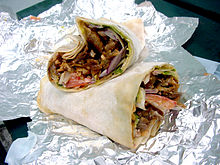 2 rolls of lamb roti roll
2 rolls of lamb roti roll
The word 'roti' in the West Indies may also refer to a dish of stewed or curried ingredients wrapped in a 'roti skin'. In Trinidad and Tobago various rotis are served. Popular variations include chicken, conch, beef and vegetable. Shrimp and goat are available. The term is used locally in cities with large West Indian populations, such as Brooklyn, Toronto and Montreal. In such locales the dish has also become popular among non-West Indians.
Roti, pronounced "Rooti" in Cape Town, is also a staple food source amongst many of the Indian, Asian and Cape coloured communities living in South Africa and is either eaten as a flat bread or a wrap with locally made curries.
While common variations may include chicken, beef, or cabbage and carrot, one of the more authentic alternatives (goat) is known as Groti.[citation needed]
In Suriname roti refers mainly to roti dahlpuri or roti aloopuri. It is most often eaten with chicken curry. Roti can also refer to a dish of stuffed and spiced roti wraps. It is custom to eat this dish by hand. Due to mass emigration of Surinam Hindustani in the 1970s, roti became a popular take-out dish in the Netherlands. It usually includes chicken curry, potatoes, a boiled egg and various vegetables, most notably the kousenband or yardlong bean. Another variation includes shrimp and aubergine. The meat with gravy, potatoes, egg and yardlong beans are served side by side on a plate, with the aloopura folded in fours on top. One then has the option to spice the dish with a very hot sambol made of Madame Jeanette peppers.
See also
- Chapati
- Puri
- Naan
- Paratha
- Kulcha
- Bhatura
- Luchi
- Roti canai
- Roti (film)
- Kottu Roti
- Wrap roti
References
- ^ The Cape Malay Cookbook - By Faldela Williams, Cornel de Kock
- ^ India - By Michael Dahl
- ^ The Food of India - By Priya Wickramasinghe, Carol Selva Rajah, Jason Lowe, Alan Benson
- ^ "Rotika (रोटिका)". Spoken Sanskrit. http://spokensanskrit.de/index.php?script=HK&tinput=%E0%A4%B0%E0%A5%8B%E0%A4%9F%E0%A4%BF%E0%A4%95%E0%A4%BE+&country_ID=&trans=Translate&direction=AU. Retrieved 2007–03–25.
- ^ Dhal Puri Recipe - NomadicGourmet.com
Pakistani dishes by cuisine and region Balochi 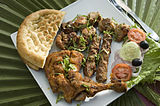
Kashmiri Muhajir Aloo tikki · Dahi chutney · Gil e firdaus · Hyderabadi biryani · Haleem · Masala chai · Nargisi Kofta · Nihari · Paan · SheermalPashtun Afghan bread · Bolani · Chapli kabab · Gosh Feel · Kabuli pulao · Kadchgall · Kadu bouranee · Kahwah · Mantu · Peshwari NaanPunjabi LahoriChargha · Golgappa · Halwa poori · Lahori fried fish · Gosht karahi · Murgh cholay · Paya · Kata-katElsewhereAloo gobi · Aloo paratha · Baingan ka bartha · Bhala · Bhatoora · Chana masala · Chapati · Chicken tikka · Chole bhature · Gajar ka Halwa · Lassi · Makki di roti · Panjiri · Papadum · Paratha · Punjabi pulao · Puri · Sarson da saag · Sohan halwa · Sugarcane juice · Tandoor bread · Tandoori chicken · TikkaSindhi Miscellaneous Pakistani diaspora  Indian breads
Indian breadsMain article Baati • Bhakri • Bhatoora • Chapati • Davanagere Benne Dosa • Dosa • Idli • Jolada rotti • Kerala porotta • Khakhra • Kulcha • Luchi • Makki di roti • Manda Pitha • Naan • Neer dosa • Papadum • Paratha • Parotta • Pathiri • Pesarattu • Pitha • Puri (food) • Puttu • Rava dosa • Roti • Rumali Roti • Sheermal • Thalipeeth • Uttapam
 Recipes on WikiBooks ·
Recipes on WikiBooks ·  Category:Indian breads ·
Category:Indian breads ·  The Food Portal ·
The Food Portal ·  The India Portal
The India PortalPakistani breads Bhatoora • Chapati • Hoyha • Kaak • Lavash • Naan • Papadum • Paratha • Phitti • Puri (food) • Roti • Rumali Roti • Sheermal • Taftan (bread)
 Recipes on WikiBooks ·
Recipes on WikiBooks ·  Category:Pakistani breads ·
Category:Pakistani breads ·  The Food Portal ·
The Food Portal ·  The Pakistan Portal
The Pakistan PortalFlatbreads Asia Barbari bread • Bazlama • Bhakri • Bhatoora • Bindaetteok • Bing • Bolani • Chapati • Dosa • Kulcha • Roast paan • Gözleme • Green onion pancake • Khanom buang • Laobing • Luchi • Malooga • Markook • Matzo • Naan • Papadum • Paratha • Pesarattu • Pita • Puri • Roti • Roti canai • Sanchuisanda • Sangak • Tandyr nan • Taboon bread • Yufka
Europe Crêpe • Crisp bread • Farl • Flammkuchen • Flatbrød • Flatkaka • Focaccia • Hoggan • Lavash • Lefse • Opłatek • Pancake • Pane carasau • Piadina • Pita • Podpłomyk • Rieska • Sacramental bread • Tunnbröd
Africa Aish Mehahra • Harsha • Injera • Lahoh • Mandezi • Ngome
Americas Arepa • Bammy • Casabe • Tortilla • Tortilla de Rescoldo
Bread List of breads Types Ingredients Equipment Processes Autolysis • Chorleywood bread process • Leavening • Maillard reaction • Proofing • Kneading • Baking • SteamingUses Other Breadmaking • Baker percentageCategories:- North Indian cuisine
- Indian breads
- Bihari cuisine
- Uttar Pradeshi cuisine
- Punjabi cuisine
- Sindhi cuisine
- Pashtun cuisine
- Balochi cuisine
- Kashmiri cuisine
- Jamaican cuisine
- Flatbreads
- Pakistani breads
- Pakistani cuisine
- Unleavened breads
- Bengali cuisine
- Punjabi words and phrases
- Somalian cuisine
- Hindi loanwords
- Gujarati cuisine
- Trinidad and Tobago cuisine
- Types of roti
- Indian inventions
- Guyanese cuisine
- Surinamese cuisine
-
Wikimedia Foundation. 2010.





